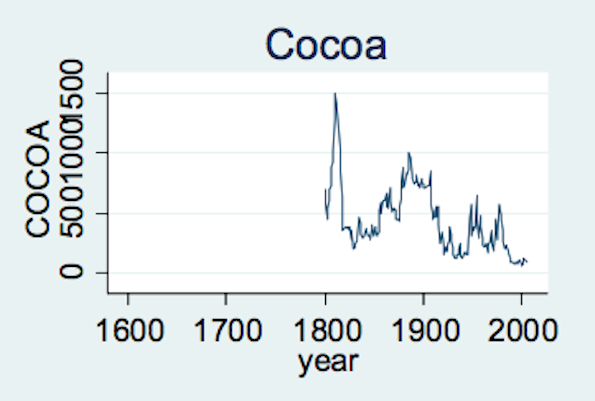Commodity price decline
A Marxist theory is (sort of) right
A new paper*
by the International Monetary Fund discusses the PSH. The authors examine 25
commodities, from sugar to silver, with some data going back to 1650. Since
1900, around 50% of the commodities show clear downward relative price slopes.
About 25% show a clear upward slope.
You will have to forgive the confusing
labelling of the graphs, but you get the idea:


These graphs show prices relative to manufactured
goods; in dollar terms many commodity prices have trended
upward over the past century. So countries that produce high levels of
primary products have, over time, done worse than economies which rely on
manufactured goods. The authors cautiously conclude that "in the majority of
cases the PSH is not rejected".
What can primary producers do about this?
In a recent conference at the IMF in Washington, one of the authors, Kaddour Hadri, suggested that commodity-dependent economies should take advantage of short periods of price spikes to invest in alternative industries. But many commodity-dependent economies fail to do this.
William Sawyer, of Texas Christian University, argues that South America has failed to take advantage of high commodity prices over the past decade. As a result, their economies are not well-equipped to deal with the current price declines.
But according to Javier Blas, a journalist for the Financial Times who spoke at the IMF conference, commodity producers have been fighting against the Prebisch-Singer hypothesis for the last century. Many have shifted production away from commodities which do relatively badly against manufactured goods. The development of the soybean market, as well as shifts towards farming of chicken and pork, are some examples of this. None of these commodities appears in the IMF paper, so it does not tell a complete story. Still, and oddly enough, the IMF seems to have turned up some evidence support a bit of Marxist economic theory.
Related exam questions:
Unit 4 June 10 - To what extent is primary product dependency a constraint on economic growth
and development in developing countries? (20 Marks)
Unit 4 June 11 - Assess the policies which might respond to rising commodity prices during a period of slow economic growth. (30 Marks)
No comments:
Post a Comment